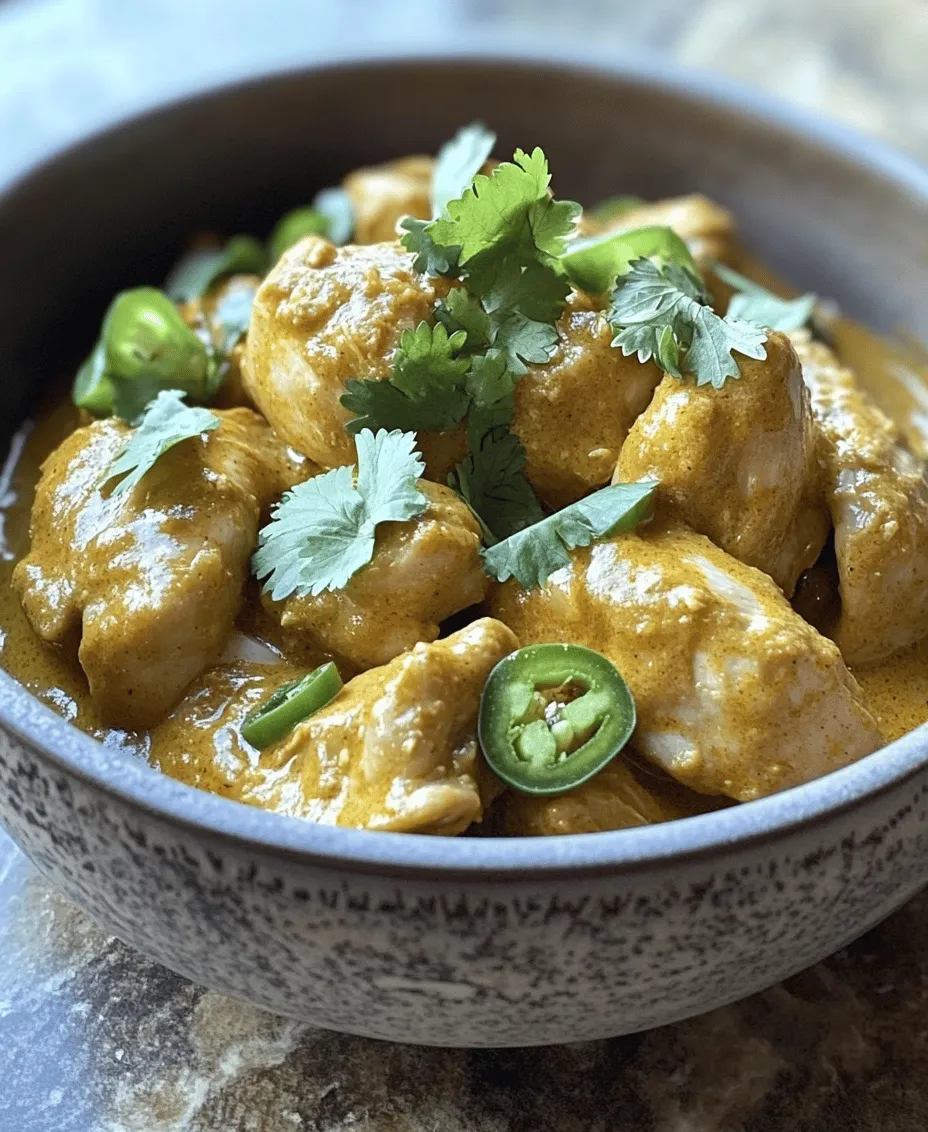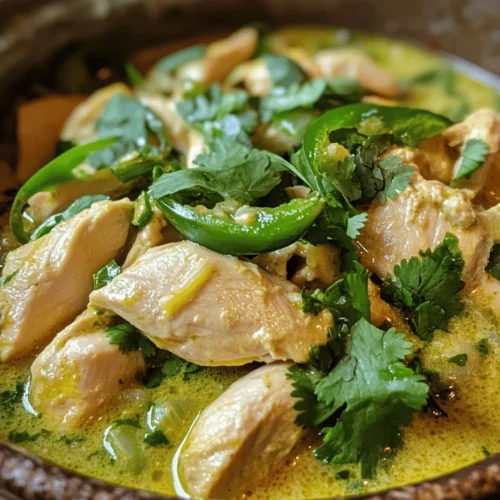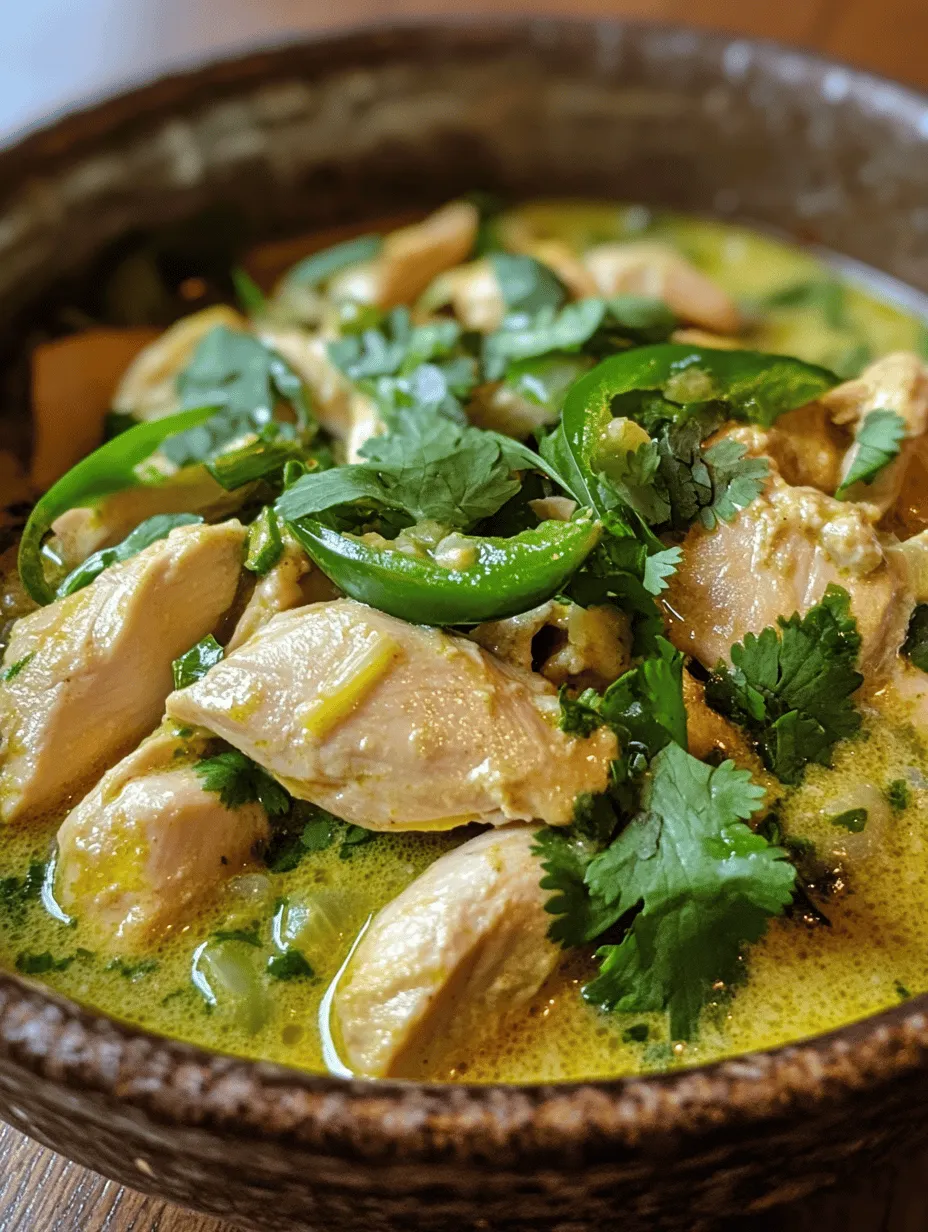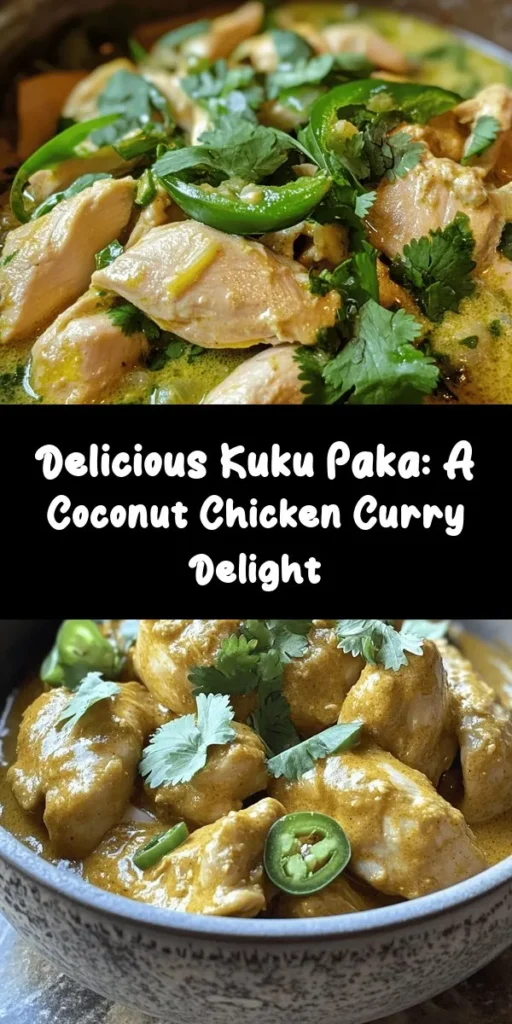Introduction
Kuku Paka, a delightful dish with roots in East African cuisine, particularly among the Swahili-speaking populations, is a culinary gem that brings a rich tapestry of flavors to the table. This traditional chicken curry, characterized by its creamy coconut milk base and a medley of spices, is not just a meal; it’s an experience steeped in history and cultural significance. The name “Kuku Paka” translates roughly to “chicken cooked in a coconut sauce,” and it reflects a harmonious blend of African, Arab, and Indian culinary influences.
As we embark on this culinary journey, let’s explore the unique flavors and aromas that make Kuku Paka a beloved dish. The combination of succulent chicken, aromatic spices, and luscious coconut milk creates an irresistible flavor profile that tantalizes the taste buds. The dish is often garnished with fresh cilantro and served with rice or flatbread, making it a versatile and satisfying meal for family gatherings or special occasions. The deliciously fragrant aroma that wafts through the kitchen while cooking is enough to stir up excitement and anticipation for this savory delight.
Understanding Kuku Paka
Historical Background of Kuku Paka
The origins of Kuku Paka can be traced back to the East African coastal regions, where trade routes facilitated the exchange of spices and culinary techniques among diverse cultures. The Swahili Coast, with its rich history of trade with Arab, Indian, and Portuguese merchants, played a pivotal role in shaping this dish. The use of coconut milk is a testament to the influence of the coastal regions, where coconuts grow abundantly and are a staple ingredient in many local dishes.
Historically, Kuku Paka was enjoyed in households across the region, reflecting the community’s connection to its agrarian roots and the abundance of local ingredients. Today, Kuku Paka is not only a staple in homes but also a popular dish in restaurants and at cultural events, symbolizing togetherness and celebration.
Regional Variations and Influences in Different Cuisines
While Kuku Paka is most commonly associated with Kenyan and Tanzanian cuisine, variations of this dish can be found throughout East Africa and beyond. In some regions, the dish may feature different proteins, such as goat or fish, adapting to local tastes and ingredient availability. Additionally, the spices used can vary, with some recipes incorporating local herbs or ingredients unique to specific cultures.
In the Indian subcontinent, similar dishes exist, showcasing the cultural exchange that has occurred over centuries. The use of spices like turmeric, cumin, and coriander in Kuku Paka is reminiscent of Indian curry traditions, while the richness of coconut milk echoes the coastal flavors of both Indian and Southeast Asian cuisines. This fusion of flavors not only enhances the dish’s appeal but also highlights the interconnectedness of culinary practices across cultures.
Nutritional Benefits of the Ingredients Used in the Recipe
Kuku Paka is not only a feast for the senses but also offers several nutritional benefits, making it a wholesome choice for any meal. The primary ingredient, chicken, is a great source of lean protein, essential for muscle health and overall wellness. Additionally, the inclusion of coconut milk provides healthy fats, particularly medium-chain triglycerides (MCTs), which can support metabolism and energy levels.
The spices used in Kuku Paka, such as ginger and garlic, bring their own health benefits. Ginger is known for its anti-inflammatory properties and can aid digestion, while garlic is rich in antioxidants and has been linked to improved heart health. Furthermore, the addition of chilies not only adds a kick of heat but also contributes vitamins A and C, along with capsaicin, which may promote metabolism.
For those looking to modify the dish for dietary preferences, Kuku Paka can easily be adapted. Substitute the chicken with plant-based proteins such as tofu or chickpeas, and use vegetable broth or almond milk in place of coconut milk for a lighter alternative. This versatility ensures that everyone can enjoy the deliciousness of Kuku Paka while meeting their nutritional needs.
Ingredients for Kuku Paka Delight
Creating a delectable Kuku Paka requires a thoughtful selection of ingredients that work together to create a symphony of flavors. Below is a detailed list of ingredients you will need, along with descriptions highlighting their importance in the dish.
Chicken: Importance of Selecting the Right Cut
The star of Kuku Paka is, of course, the chicken. For this recipe, bone-in chicken pieces such as thighs or drumsticks are recommended. These cuts are not only more flavorful due to the bone but also remain tender and juicy throughout the cooking process. If you prefer, boneless chicken breast can be used, but be sure to adjust the cooking time accordingly, as it cooks faster than bone-in cuts.
Coconut Milk: Role in Flavor and Richness
Coconut milk is the heart of Kuku Paka, providing a creamy texture and a subtle sweetness that balances the spices. When selecting coconut milk, opt for full-fat versions for the richest flavor. If you’re looking for a lighter option, light coconut milk can be used, but keep in mind that it may alter the dish’s creaminess.
Spices: Overview of Spices Used and Their Health Benefits
The flavor of Kuku Paka is enhanced by a blend of spices that create a unique and aromatic experience. Commonly used spices include:
– Turmeric: Known for its anti-inflammatory properties and vibrant color.
– Cumin: Adds earthiness and depth to the dish, aiding in digestion.
– Coriander: Offers a warm, citrusy flavor and is rich in antioxidants.
– Garam Masala: A fragrant spice blend that elevates the flavor profile of the dish.
– Red Pepper Flakes or Fresh Chilies: Provides the desired heat level, contributing to the dish’s aromatic complexity.
These spices not only enhance the taste but also offer various health benefits, making Kuku Paka a nutritious option.
Discussion on Ingredient Substitutions for Dietary Preferences
Kuku Paka can easily be modified to suit different dietary needs. For vegetarians, a combination of hearty vegetables such as eggplant, bell peppers, and spinach can be used in place of chicken. For a vegan option, replace chicken with tofu or tempeh, and use vegetable broth instead of chicken broth while still maintaining the use of coconut milk for creaminess.
Additionally, if you prefer a grain-free dish, serve Kuku Paka with cauliflower rice instead of traditional rice, allowing for a healthier, low-carb alternative.
Preparation Steps for the Perfect Kuku Paka
Creating the perfect Kuku Paka requires attention to detail, particularly during the preparation stages. Here are the essential steps to ensure your dish is bursting with flavor.
Importance of Marinating the Chicken
One of the keys to achieving flavor-packed Kuku Paka is marinating the chicken. Marination not only infuses the meat with spices but also helps to tenderize it, resulting in a juicier, more flavorful dish.
Explanation of How Marination Enhances Flavor
When chicken is marinated, it absorbs the flavors of the spices, garlic, and ginger, allowing each bite to deliver a burst of taste. The acids from ingredients like yogurt or lemon juice (if added) help to break down protein fibers, making the chicken tender and juicy.
Suggested Marination Times for Best Results
For optimal flavor, marinate the chicken for at least 30 minutes, but for the best results, aim for 2 to 4 hours. If time allows, overnight marination in the refrigerator is ideal, as it allows the spices to penetrate deeply into the meat, ensuring maximum flavor.
Sautéing Onions and Aromatics
Once the chicken is marinated, the next step involves sautéing onions and aromatics. Start by heating oil in a large pan or pot over medium heat. Add finely chopped onions and sauté until they’re translucent and lightly caramelized. This process is crucial as it lays the foundation for the dish’s flavor, creating a sweet, savory base that will complement the spices and coconut milk.
Techniques for Achieving the Right Level of Caramelization
To achieve the perfect caramelization, avoid overcrowding the pan, as this can lead to steaming rather than browning. Stir occasionally to ensure even cooking, and don’t rush the process; the goal is to develop a deep golden color without burning the onions. This caramelization adds complexity to the dish, contributing a subtle sweetness that balances the spiciness of the chilies.
The Role of Garlic, Ginger, and Chilies in Building Flavor
Garlic and ginger are essential aromatics in Kuku Paka, providing depth and a fragrant aroma that elevates the dish. Add minced garlic and ginger to the sautéed onions and cook for an additional minute until fragrant. The flavors should meld together, creating a rich base for the curry.
If you enjoy heat, this is also the stage to add finely chopped fresh chilies or a sprinkle of red pepper flakes. Adjust the amount according to your spice tolerance, as this will significantly impact the dish’s final flavor profile.
As we continue to explore the delightful intricacies of Kuku Paka, the next steps will delve deeper into combining these aromatic elements with the marinated chicken and coconut milk to create a dish that is not only satisfying but also memorable. Stay tuned for the next part, where we will guide you through the cooking process and final touches that bring this savory delight to life.

Browning the Chicken
Browning the chicken is a crucial step in preparing Savory Kuku Paka. This process not only enhances the visual appeal of the dish but also significantly contributes to its flavor profile. When chicken pieces are browned, the Maillard reaction occurs, creating complex flavors that are foundational to the final taste of the dish.
Importance of Browning for Depth of Flavor
Browning adds depth and richness to Kuku Paka. The caramelization that occurs during this process imparts a savory, slightly sweet flavor, which contrasts beautifully with the creamy coconut milk and spices. This layering of flavors is essential, as it creates a well-rounded dish that tantalizes the taste buds.
Tips for Achieving Perfectly Browned Chicken
To achieve perfectly browned chicken, consider the following tips:
1. Pat the Chicken Dry: Use paper towels to remove excess moisture from the chicken pieces. This step ensures that the chicken sears instead of steams, leading to better browning.
2. Use High Heat: Preheat your pan over medium-high heat before adding oil. A hot surface is key to achieving that golden-brown crust.
3. Don’t Overcrowd the Pan: Cook the chicken in batches if necessary. Overcrowding can lower the pan’s temperature, preventing proper browning.
4. Let it Cook Undisturbed: After placing the chicken in the pan, let it sear without moving it around too much. This allows for better browning on one side before flipping.
5. Use the Right Oil: Choose an oil with a high smoke point, such as vegetable oil or ghee, to withstand the high cooking temperatures without burning.
Adding Spices and Cooking Techniques
Once the chicken is beautifully browned, it’s time to incorporate the spices that will define your Kuku Paka. This step involves not just adding spices but also employing specific cooking techniques that enhance their flavors.
Explanation of Toasting Spices and Its Effects on Flavor
Toasting spices before adding them to your Kuku Paka releases their essential oils, intensifying their flavors. This technique is simple yet impactful:
1. Heat a Dry Pan: Place a small, dry skillet over medium heat.
2. Add Whole Spices: If your recipe calls for whole spices, add them to the pan.
3. Stir Constantly: Keep stirring the spices for about 2-3 minutes until they are fragrant and slightly darkened in color.
4. Cool and Grind: Remove from heat, let them cool, and then grind them into a powder if necessary.
Toasting spices not only elevates the dish but also provides a deeper, more aromatic profile that complements the richness of the coconut milk.
Incorporating Liquids
After the spices have been added, it’s time to incorporate the liquids that will form the base of your creamy sauce.
Significance of Chicken Broth and Coconut Milk in Creating the Sauce
Chicken broth and coconut milk are integral to Kuku Paka. The broth adds a savory depth, while the coconut milk provides a creamy texture and subtle sweetness. The combination creates a luscious sauce that clings beautifully to the chicken.
1. Add Chicken Broth: Pour in the chicken broth after toasting the spices and browning the chicken. This will help deglaze the pan, lifting any browned bits stuck to the bottom, which adds even more flavor to the sauce.
2. Incorporate Coconut Milk: Once the broth is simmering, stir in the coconut milk. This should be done gently; avoid boiling the coconut milk to prevent it from curdling.
Cooking Time and Monitoring Doneness
The cooking time for Kuku Paka is crucial for achieving tender chicken that is infused with the sauce’s flavors.
Importance of Simmering for Tenderness and Flavor Absorption
Once all the ingredients are combined, reduce the heat to low and let the dish simmer. Simmering allows the chicken to cook gently, absorbing all the flavors from the broth and spices while becoming tender.
1. Simmer the Dish: Cover the pot and let it simmer for about 20-30 minutes, depending on the size of the chicken pieces.
2. Monitor the Chicken: Stir occasionally and check for doneness. Chicken should reach an internal temperature of 165°F (75°C).
Signs to Look for to Ensure Chicken is Cooked Properly
To ensure your chicken is perfectly cooked, look for the following signs:
– The juices should run clear when the chicken is pierced.
– The meat should be opaque and no longer pink.
– The chicken should feel tender and easily pull away from the bone if using bone-in pieces.
Serving Suggestions for Kuku Paka
Kuku Paka is versatile and can be enjoyed in various ways. Here are some serving suggestions to enhance your dining experience.
Ideal Pairings with Rice, Chapati, or Other Sides
The creamy sauce of Kuku Paka pairs beautifully with:
– Steamed Basmati Rice: The light, fluffy rice absorbs the sauce, making each bite delicious.
– Chapati or Naan: These flatbreads are perfect for scooping up the chicken and sauce.
– Couscous or Quinoa: For a healthier twist, serve with whole grains that soak up the flavors.
Presentation Tips for an Appealing Dish
Presentation is key to an inviting meal. Consider these tips:
– Garnish with Fresh Herbs: Sprinkle chopped cilantro or parsley on top for a fresh touch.
– Serve in a Beautiful Dish: Use a large serving platter or individual bowls that highlight the vibrant colors of the dish.
– Add a Side Salad: A simple cucumber salad with a squeeze of lemon can add a refreshing contrast.
Ideas for Side Dishes and Accompaniments That Complement Kuku Paka
To elevate your meal, consider adding:
– Sautéed Vegetables: Lightly sautéed greens or seasonal vegetables can add color and nutrition.
– Pickles or Chutneys: A tangy mango chutney or lemon pickle can enhance the flavors of the Kuku Paka.
– Yogurt Sauce: A cooling yogurt sauce seasoned with herbs can balance the dish’s spices.
Culinary Variations on Kuku Paka
While Kuku Paka has its roots in East African cuisine, there are many ways to adapt the recipe to suit different tastes and dietary preferences.
Exploring Different Regional Adaptations of the Dish
Kuku Paka has variations across regions, each adding unique spices or ingredients. For instance:
– In coastal areas, lime and coriander may be added for a zesty twist.
– Some versions include peanuts or cashews, which add richness and texture.
Suggestions for Adding Vegetables or Alternative Proteins
To make Kuku Paka more nutritious or cater to vegetarian diets, consider these options:
– Add Vegetables: Incorporate bell peppers, carrots, or spinach during cooking for added nutrition and color.
– Alternative Proteins: Substitute chicken with tofu or chickpeas, ensuring to adjust cooking times accordingly to achieve tenderness.
Creative Twists to the Traditional Recipe That Maintain Its Essence
For those looking to experiment while staying true to the dish’s essence, try:
– Spicy Versions: Increase the amount of chili or add a dash of hot sauce for an extra kick.
– Cooking with Citrus: Adding lime or lemon juice just before serving can brighten the flavors.
Conclusion
Kuku Paka is more than just a dish; it represents the cultural melding of flavors and traditions. Its unique combination of spices, coconut milk, and tender chicken creates a comforting meal that resonates deeply with those who enjoy it. The beauty of this dish lies not only in its rich flavors but also in the stories shared around the table while enjoying it.
We encourage you to explore Kuku Paka in your home cooking. Whether you stick to the traditional recipe or add your personal touch, this dish offers an opportunity to experience a taste of East Africa. Sharing meals like Kuku Paka fosters connections, evokes memories, and creates new stories, making every dining experience a cherished one. Embrace the joy of cooking and the delight of sharing this savory dish with family and friends!



